English (Reading and Writing)
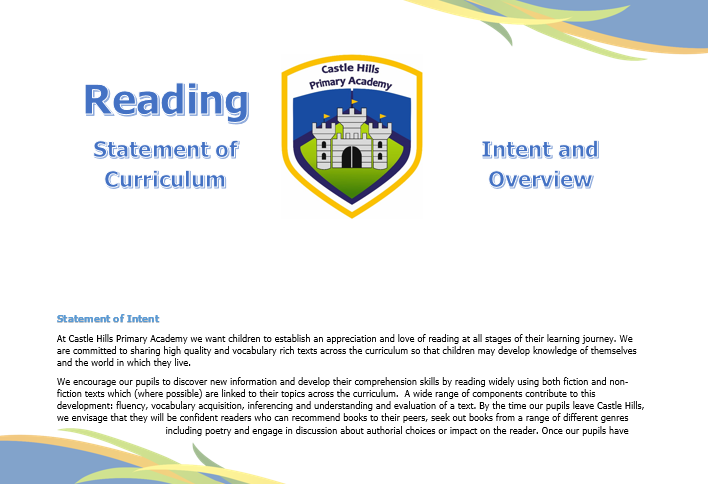
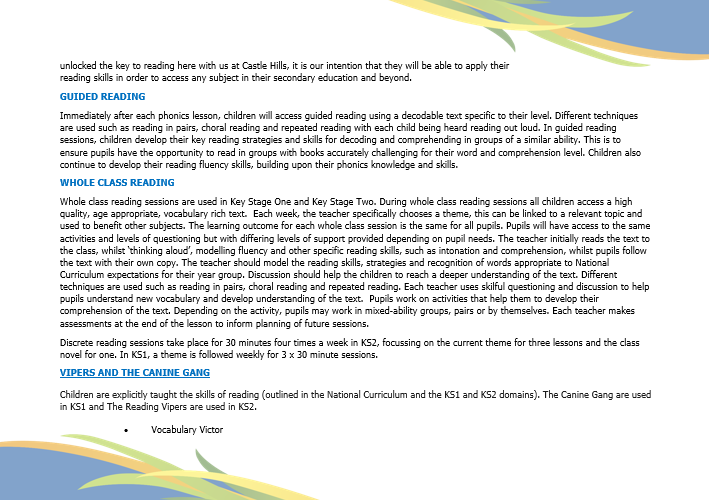
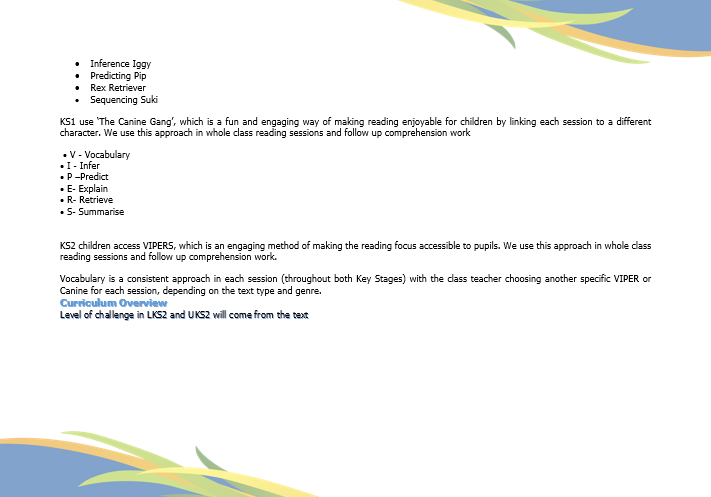
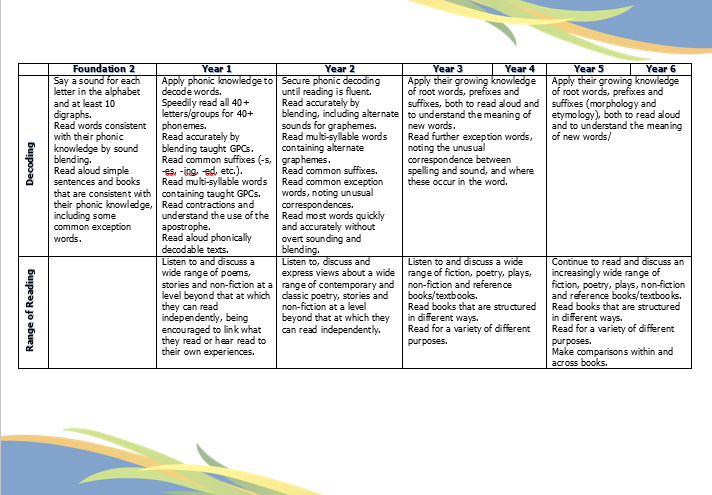
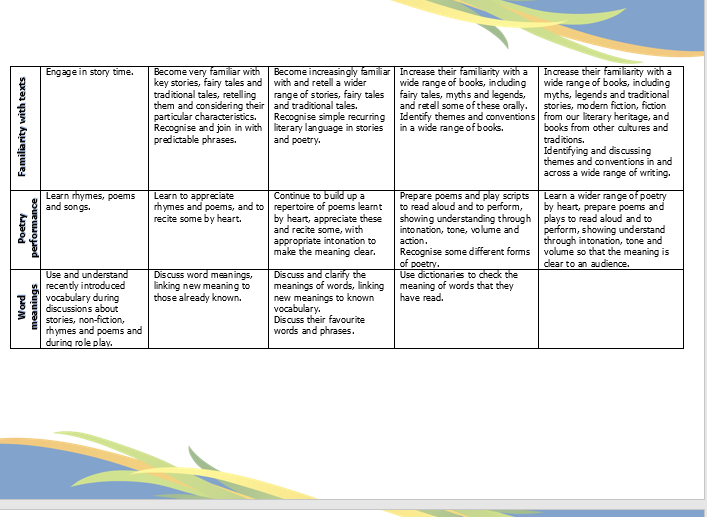
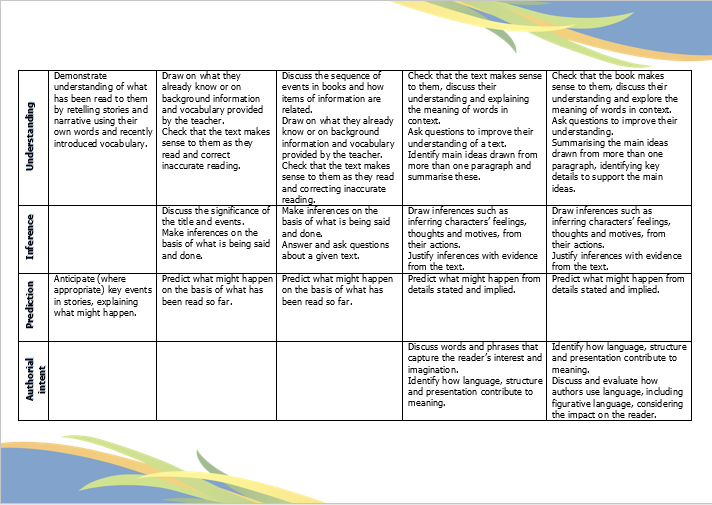
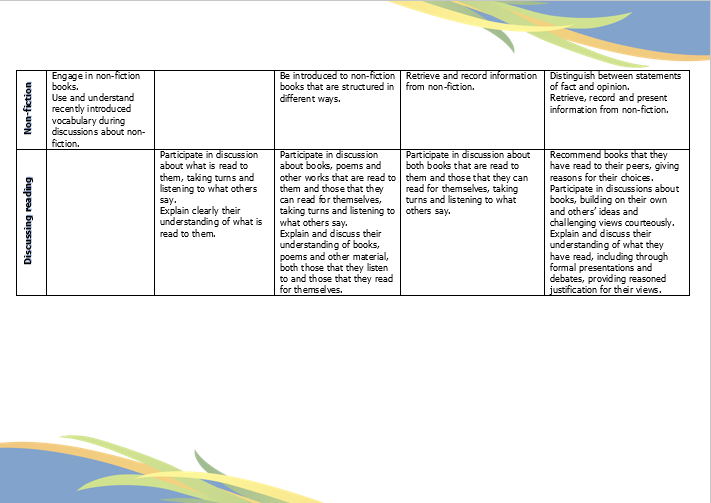
Phonics Intent
Castle Hills Primary Academy
Phonics Statement of Intent
INTENT
High-quality phonic teaching secures the crucial skills of word recognition that, once mastered, enable children to read fluently and automatically. Once children are fluent readers, they are able to concentrate on the meaning of the text.
The ‘simple view of reading’ shows that both dimensions are necessary to achieve fluent reading. However, the balance between word recognition and language comprehension shifts as children acquire secure and automatic decoding skills and progress from ‘learning to read’ to ‘reading to learn’ for purpose and pleasure. The ultimate goal of learning to read is comprehension.
As children develop knowledge of graphemes and their phoneme correspondences they are able to segment words and apply their phonic knowledge to encode to spell with increasing confidence and accuracy.
We follow the ‘Twinkl Phonics’ scheme throughout the whole school.
IMPLEMENT
OUR PHONICS PLANNING:
- It is time-limited, such that the vast majority of children should be confident readers by the end of Key Stage 1. Most children consolidate phonic skills in the Foundation Stage and Key Stage 1.
- It follows a planned programme, building on previous learning to secure progress.
- It is taught daily in the morning when children are fresh.
- It reinforces and applies acquired phonic knowledge and skills as they progress through their phonics.
- It ensures children progress in developing and applying their phonic knowledge by assessing this.
- It is differentiated to provide for the needs of all children. Phonics lessons are streamed from F2 to Year 1 to ensure sessions are differentiated accordingly.
Daily phonics Sessions are 60 minutes long, throughout the day. The direct phonics lesson is for 30 minutes followed by a decodable reading session for the remainder of the session. Class Teachers will set up high quality Phonics Folders for each level and set which are quality assured by the Phonics Champion termly. Classroom environments will reflect current teaching and support learning. All classrooms are to include:
On the table- mnemonic sound cards, tricky/ common exception word mats, letter formation mats and phoneme frames.
On the wall- GPC frieze display, letter formation rhyming posters, tricky/ common exception word display, Kim and Sam’s sounds display, sound family poster (KS1).
AGE RELATED EXPECTATIONS WITHIN CASTLE HILLS PRIMARY ACADEMY
Although the six-level structure provides a useful map from which to plan children’s progress, the boundaries between the levels should not be regarded as fixed. Guided by reliable assessments of children’s developing knowledge and skills, practitioners and teachers will need to judge the rate at which their children are able to progress through the levels and adapt the pace accordingly. As with much else in the early years, some children will be capable of, and benefit from, learning at a faster pace than their peers whereas others may need more time and support to secure their learning. Pupils are assessed and then grouped into the appropriate phase for their understanding. Phonics lessons are delivered at the same time across the phases so groups can be fluid and facilitates pupils to swap groups where appropriate.
NURSERY
In Nursery, children enjoy learning Nursery Rhymes and voice-play songs. Rhymes sensitise a child to the individual units of sound that make up a word. The rhythms present in Nursery Rhymes help children to remember the words, exercising their auditory memory skills. In line with the rest of the school, we follow the ‘Twinkl Phonics’ Programme, starting in level one.
Level One activities are arranged under the following seven aspects.
- Aspect 1: General sound discrimination – environmental sounds
- Aspect 2: General sound discrimination – instrumental sounds
- Aspect 3: General sound discrimination – body percussion
- Aspect 4: Rhythm and rhyme
- Aspect 5: Alliteration
- Aspect 6: Voice sounds
- Aspect 7: Oral blending and segmenting
By the end of Level 1, children will:
- have experienced a wealth of listening activities, including songs, stories and rhymes.
- be able to distinguish between speech sounds and many will be able to blend and segment words orally.
Once children are secure with level one they are moved on to level 2 in nursery.
RECEPTION
Children continue to use level one as the speaking and listening activities continue across all levels.
Term 1 & 2 – Twinkl Phonics – Level 2 (7weeks)
By Christmas, most children will be secure in these sounds and be having a good go at blending (synthesising) simple CVC words. A vast amount of blending will take place using the sounds correctly and segmenting orally and in spelling VC and CVC words.
By the end of Level 2, children should be able to:
-Give the phoneme when shown any Level 2 grapheme
- Find any Level two grapheme, from a display, when given the phoneme.
-Orally blend and segment CVC words
-Blend and segment in order to read and spell (using magnetic letters) VC words, such as if, am, on, up and nonsense words, such as ip, ug and ock.
-Read the five tricky words - the, to, I, no, go.
Terms 3 & 4 – Twinkl Phonics- Level 3 (12 weeks)
By Easter, most children are secure to the end of Phase 3, knowing the basic digraphs and long vowel sounds. They are reading the majority of the Phase 2 and Phase 3 High Frequency words (45 words) and they are able to read and write simple sentences.
By the end of Level 3, children should be able to:
-Give the phoneme when shown all or most Level 2 and Level 3 graphemes
- Find all or most Level 2 and Level 3 graphemes, from a display, when given the phoneme.
-Blend and read CVC words (single-syllable words consisting of Level two and Level three graphemes).
-Segment and make a phonetically plausible attempt at spelling CVC words (single-syllable words consisting of Level 2 and Level 3 graphemes).
-Read the tricky words - he, she, we, me, be, was, my, you, her, they, all, are.
-Spell the tricky words - the, to, I, no, go.
- Write each letter correctly when following a model.
Terms 5 & 6 – Twinkl Phonics Level 4 (5 weeks)
Period of consolidation of the 42 graphemes through blending and segmenting CCVC and CVCC words with consonant clusters.
By the end of Reception, most children are secure in Level 4.
By the end of Level 4, children should be able to:
-Give the phoneme when shown any Level 2 and Level 3 grapheme.
-Find any Level 2 and Level 3 grapheme, from a display, when given the phoneme.
-Be able to blend and read words containing adjacent consonants.
-Be able to segment and spell words containing adjacent consonants.
-Be able to read the tricky words - some, one, said, come, do, so, were, when, have, there, out, like, little, what.
-Be able to spell the tricky words - he, she, we, me, be, was, my, you, her, they, all, are.
-Write each letter, usually correctly.
KS1
In Year 1 and Year 2, children will continue to use ‘Twinkl Phonics’. All classrooms will have the same expectation with the resources (see the list above).
YEAR 1
Term 1 – Twinkl Phonics Level 4 and teach any level 3 gaps.
Review of Level 3 graphemes and consolidation of the 42 graphemes through blending and segmenting CCVC and CVCC words with consonant clusters.
Children who are not working at Level 4 in Term 1 will be identified and invited to attend an after-school Phonics Club.
Term 2 Onwards – Twinkl Phonics Level 5 (30 weeks)
The purpose of this level is for children to broaden their knowledge of graphemes and phonemes for use in reading and spelling. They will learn new graphemes and alternative pronunciations for these and graphemes they already know, where relevant. Some of the alternatives will already have been encountered in the high-frequency words that have been taught. Children become quicker at recognising graphemes of more than one letter in words and at blending the phonemes they represent. When spelling words they will learn to choose the appropriate graphemes to represent phonemes and begin to build word-specific knowledge of the spellings of words.
At the end of each term, assessments are made and children that are not working at the expected level begin Rapid Phonics Intervention program at the beginning of the next term.
In June, children in Year 1 will undertake the National Phonics Screening Check. The school sets targets each year for teachers to exceed the national average pass rate for children taking the Screening Check.
By the end of Level 5, children should be able to:
-Give the phoneme when shown any grapheme that has been taught.
-For any given phoneme, write the common graphemes.
-Apply phonics knowledge and skills as the prime approach to reading and spelling unfamiliar words that are not completely decodable.
-Read and spell phonically decodable two-syllable and three-syllable words.
-Read automatically all the words in the list of 100 high-frequency words.
-Accurately spell most of the words in the list of 100 high-frequency words.
-Form each letter correctly.
-Use alternative ways of pronouncing and representing the long vowel phonemes.
YEAR 2- Twinkl Phonics Level 6 (30 weeks)
Most children will begin Year 2 secure in level 5 of Twinkl Phonics. By the beginning of Level 6, children should know most of the common grapheme- phoneme correspondences (GPCs).
By the end of Level 6, children should be able to:
-Read accurately most words of two or more syllables.
-Read most words containing common suffixes.
-Read most common exception words.
-Read most words accurately, in age appropriate books, without overt sounding and blending, and sufficiently fluently to allow them to focus on their understanding rather than on decoding individual words.
-Sound out most unfamiliar words accurately, without undue hesitation.
-Segment spoken words into phonemes and represent these by graphemes, spelling many of these words correctly and making phonically-plausible attempts at others.
-Spell most common exception words correctly.
In Year 2, children working below age-related expectations will be supported in small groups to work on Phonics. Some Year 2 children may take part in Phonics lessons in Year 1 in addition to their sessions in Year 2.
Re-screening will take place in June and all Non-SEND children are expected to pass the check at the second attempt.
ASSESSMENT
Assessments are undertaken each half term and the children’s progress is recorded on the ‘Twinkl Phonics’ assessment document. Once this is complete, the data will be sent to the phonics champion to analyse.
Regular assessments will help to determine the appropriate level of phonics teaching for the next term and any additional intervention required.
Children will be assessed using:
- Twinkl Phonics Assessment
- Reading diary scrutiny
- Reading of non-words and tricky words
- Phonic screening mock tests.
- Decodable books they are currently working on.
WHAT WE DO IF WE FEEL A CHILD IS NOT MAKING PROGRESS?
- Support plans
- Investigate auditory problems
- Additional support in EYFS in S&L groups
- More appropriate differentiated support
- Varying the resources being used
- Rapid Phonics Intervention Programme (HLTA)
IMPACT
All pupils are confident readers by the end of Key Stage 1. They are able to use their knowledge of phonics in reading and spelling new words. All pupil groups make at least expected progress and any concerns are identified and acting upon early. Phonics screening pass rates are above National Standards and pupils develop a love for reading and can apply their phonics skills confidently.
